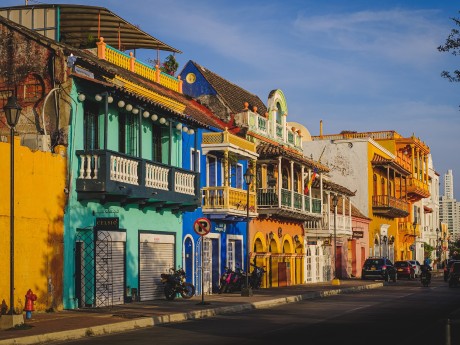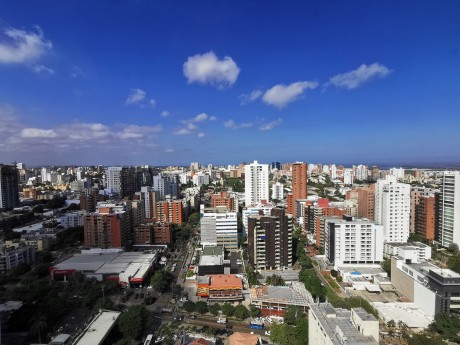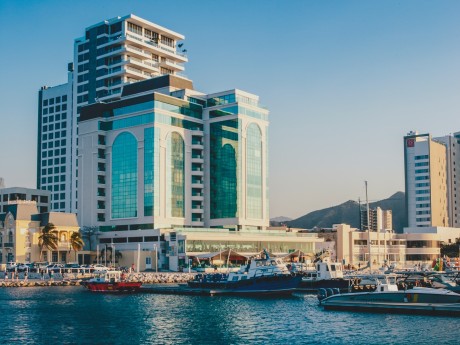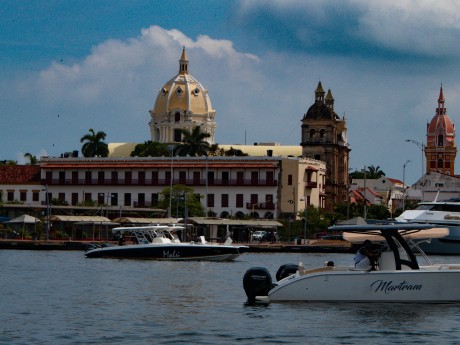Northern Colombia: Cartagena, Barranquilla & Santa Marta
Embark on a captivating journey along Colombia's Caribbean coast. From the historic charm of Cartagena to the cultural fusion of Barranquilla and the natural beauty of Santa Marta beaches, our curated itinerary ensures a seamless exploration of these coastal gems. In Cartagena, immerse yourself in the historic Old Town and the imposing San Felipe de Barajas Castle.
Read more
Embark on a captivating journey along Colombia's Caribbean coast. From the historic charm of Cartagena to the cultural fusion of Barranquilla and the natural beauty of Santa Marta beaches, our curated itinerary ensures a seamless exploration of these coastal gems. In Cartagena, immerse yourself in the historic Old Town and the imposing San Felipe de Barajas Castle. In Discover a fusion of culture at the Museo del Caribe, stroll along the Bocas de Ceniza and savor the Caribbean breeze while in Barranquilla. In Santa Marta, hike to the ancient Lost City, and unwind on Taganga's idyllic beaches. Renting a car is recommended to go at your own pace and enjoy the views along the way. This unforgettable adventure is a blend of history, natural beauty, delicious foods and rich culture. Waterviews strives to offer accommodation options within walking distance of water and/or in an area of touristic interest. Our prices include taxes (but excludes local tourist taxes). Customize your trip to your personal preferences with optional activities (hit the “Add Activities’’) or change hotels, etc. Contact us for customization at no extra cost at: Service@waterviewstravel.com
Destinations
- Cartagena (Colombia)
- Barranquilla
- Santa Marta
Itinerary
Cartagena (Colombia)

The city of Cartagena is undoubtedly one of Colombia’s most charming, offering a mesmerising blend of culture and history. The cobblestone streets and charming plazas of Cartagena’s UNESCO World Heritage listed Old Town are lined with colourful colonial-era buildings, historic churches and laid-back cafes, and come alive at night time with an array of bustling bars and restaurants. Nearby, Isla de Barú dazzles with its white sand beaches, turquoise waters and coral reefs.
Read more
The city of Cartagena is undoubtedly one of Colombia’s most charming, offering a mesmerising blend of culture and history. The cobblestone streets and charming plazas of Cartagena’s UNESCO World Heritage listed Old Town are lined with colourful colonial-era buildings, historic churches and laid-back cafes, and come alive at night time with an array of bustling bars and restaurants. Nearby, Isla de Barú dazzles with its white sand beaches, turquoise waters and coral reefs.
Additional Information
Cartagena has almost 1 million inhabitants, and is on the northern coast at the Caribbean Sea. Founded by the Spanish in 1533, it was fortified and functioned as the center of the Inquisition in the region. The impressive buildings from the Spanish time today make up a UNESCO World Heritage site.
Cartagena is the most visited city in the country by tourists. It gets extremely crowded in the December holidays and the holy week, when schools are out and most Colombians take their vacations. The city has basically two main parts where tourists go: the walled colonial city ("ciudad amurallada"), which is truly amazing and has many fancy restaurants, clubs and hotels; and a long strip of hotel towers and condos fronting onto the beach, known as Bocagrande. It is also nice to visit the exclusive neighborhood of Castillogrande, filled with recently built condos, places to jog, and a quiet beach to soak up some sun.
Being in the tropics, the climate of the city is defined by dry and rain seasons. The dry season is from December to April and it also rains a little less in July. Nevertheless, there are still on average more sunny than rainy days per month in the rainy season. Apart from September and October, the monthly amount of rain isn't much more than 100 mm. Thanks to this, the temperature is also quite constant around the year with daytime highs of +32°C and nighttime lows of +23°C. Also, there are small Tourist kiosks on Plaza de San Pedro Claver and on Plaza de los Coches.
© Sourced from Wikivoyage
Barranquilla

A bustling port city in Colombia’s Atlántico region, Barranquilla is a vibrant and sun-soaked destination that dazzles with its authentic atmosphere. The city is renowned for its annual Carnival, where locals and visitors alike prepare for days of street parties and performances. When you’re not dancing the night away, be sure to wander the city’s streets, admire its historic churches and visit its interesting museums, you won't be disappointed.
Read more
A bustling port city in Colombia’s Atlántico region, Barranquilla is a vibrant and sun-soaked destination that dazzles with its authentic atmosphere. The city is renowned for its annual Carnival, where locals and visitors alike prepare for days of street parties and performances. When you’re not dancing the night away, be sure to wander the city’s streets, admire its historic churches and visit its interesting museums, you won't be disappointed.
Additional Information
Barranquilla is a cosmopolitan and primarily industrial city, often visited by businessmen of all nationalities. However the main attraction for tourism is its carnival "Carnaval de Barranquilla," that takes place during the four days before Ash Wednesday. In November 2003, UNESCO proclaimed it as one of 28 different "masterpieces of the oral and intangible heritage of humanity".
Barranquilla is also called by its residents and Colombians in general "Curramba" (from a language game, in synthesis, Curramba is a reference to "party") and the Golden Gate to Colombia (Puerta de Oro de Colombia), this due to its location on the delta of the Magdalena river, making it the most important commercial sailing port to the Atlantic Ocean for the nation.
Residents are known as "Barranquilleros" and are characterized by their outgoing and friendly attitude and relaxed behavior. This makes the average barranquillero an optimistic and open individual, as well as goal-directed and hard-working.
© Sourced from Wikivoyage
Santa Marta

Set on Colombia’s north coast, the city of Santa Marta is a mesmerising destination that offers both culture, history and nature. Santa Marta was the first European settlement in Colombia, and today offers a beautiful collection of colourful colonial-era architecture that will transport you back in time. The city also serves as the gateway to the magnificent Tayrona National Natural Park, where you can explore lush rainforest, secluded coves and crystal-clear coastal lagoons.
Read more
Set on Colombia’s north coast, the city of Santa Marta is a mesmerising destination that offers both culture, history and nature. Santa Marta was the first European settlement in Colombia, and today offers a beautiful collection of colourful colonial-era architecture that will transport you back in time. The city also serves as the gateway to the magnificent Tayrona National Natural Park, where you can explore lush rainforest, secluded coves and crystal-clear coastal lagoons.
Additional Information
Santa Marta an important commercial port and tourist destination. Every day, there are cargo ships coming and going and the action is very much visible. From the beach, the view of the Caribbean Sea is more or less to the west (beautiful sunsets) with a huge rock of an island jutting up out of the water to make a somewhat dramatic effect. Off to the right is the port snug behind another even bigger rock. This is a decent beach if you like beaches that are right in town with lots of people, vendors, and noise. Vendors are extremely aggressive if you are on the beach.
Aside from the old center, the main attractions of Santa Marta are its two resort-like suburbs El Rodadero, to the south, and Taganga, to the north. El Rodadero has several high-end hotels and private "clubs" that cater mostly to wealthy Colombians, whereas Taganga used to be a fishing village and is very popular with (mostly foreign) backpackers. Taganga has many scuba-diving agencies.
There is a high season and low season. High season is December through April, with its peak from mid-December to late January (due to school and university vacations).
© Sourced from Wikivoyage





